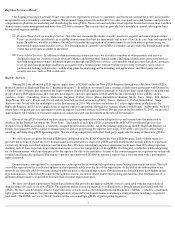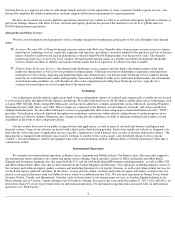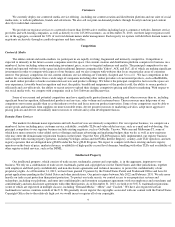Enom 2013 Annual Report Download - page 19
Download and view the complete annual report
Please find page 19 of the 2013 Enom annual report below. You can navigate through the pages in the report by either clicking on the pages listed below, or by using the keyword search tool below to find specific information within the annual report.
this service offering, we need to continue to generate new customers and maintain our existing customers. If our existing and prospective content
solutions customers do not perceive our content to be driving performance for their business, we may not be able to retain our current customers,
expand our content solutions offering on the websites of our current customers or identify and attract new customers. If we are unable to attract
new customers or retain our existing customers for our content solutions offering, our results of operations could be lower than expected.
Mobile devices, such as smartphones and tablets, are increasingly being used to access the Internet and our online media services may not be
as effective when accessed through these devices. Additionally, mobile advertising yields are lower on average than those for desktop and
laptop computers, which could negatively impact our business, financial condition and results of operation.
Historically, our content and media service offerings were designed for consumption on a desktop or laptop computer. However, the
number of people who access the Internet through mobile devices such as smartphones and tablets has increased substantially in recent years.
The smaller screens, lower resolution graphics and less convenient typing capabilities of these devices may make it more diff icult for visitors to
respond to our content and media offerings. If we cannot effectively distribute our content, products and services on these devices, we could
experience a decline in page views and traffic and corresponding revenue. It is also more difficult to display advertisements on mobile devices
without disrupting the consumer experience. We may make changes to the layouts and formats of our mobile web optimized site in order to
improve the user experience, which could negatively impact our monetization efforts on mobile devices. In addition, mobile advertising yields
on average are currently lower than those for desktop and laptop computers. The continued increase in mobile consumption of our content,
which is now contributing significantly higher page view growth as compared to page view growth from desktop or laptop computers, has
resulted in a reduction in our RPMs. If our content and media service offering on mobile devices is less attractive to advertisers and this segment
of Internet traffic increases at a faster rate than traditional desktop or laptop Internet access, our business, financial condition and results of
operations may be negatively impacted.
We depend upon the quality of traffic
to our websites, our network of customer websites and the portfolios of domain names owned by us and
our customers to provide value to online advertisers , and any failure in our quality control could have a material adverse effect on the value
of such websites to our third-party advertisement distribution providers and online advertisers and thereby adversely affect our revenue.
We use technology and processes to monitor the quality of, and to identify any anomalous metrics associated with, the Internet traffic that
we deliver to online advertisers though
our websites, our network of customer websites and the portfolios of domain names owned by us and our
customers. These metrics may be indicative of low quality clicks such as non-human processes, including robots, spiders or other software; the
mechanical automation of clicking; and other types of invalid clicks or click fraud. Even with such monitoring in place, there is a risk that a
certain amount of low-quality traffic, or traffic that is deemed to be invalid by online advertisers, will be delivered to such online advertisers. As
a result, we may be required to credit future amounts owed to us by our advertising partners or repay them for amounts previously received if
such future amounts are insufficient. Furthermore, low-quality or invalid traffic may be detrimental to our relationships with third-party
advertisement distribution providers and online advertisers, and could adversely affect our revenue.
Our new commerce initiatives, including the sale of certain products and on-demand services, including paid subscriptions, may not be
successful due to a number of factors. If we are unsuccessful in implementing and marketing our commerce initiatives, our business,
financial condition and results of operations could be adversely affected.
We have recently begun to sell certain products, including print-on-demand products, and offer on-demand services for purchase ,
including paid subscriptions to access certain of our media content, as an expansion of our content services. In order to accelerate these
commerce initiatives, in June 2013 we acquired Society6, a digital artist marketplace and e-commerce platform that enables a large community
of talented artists to sell their original designs on art prints and other products. We have not previously offered these products and services and
have limited experience in implementing, marketing, managing and growing these revenue streams.
The success of our commerce initiatives is dependent upon a number of factors, including:
17
1
demand for these products and services and our ability to attract customers to our websites selling these products and services;
1
market acceptance, increased brand awareness and the reputation of these products and services;
1
the success and competitiveness of new entrants into the highly competitive e
-
commerce marketplace;
1
fluctuations in sales and marketing costs, including traffic acquisition costs;
























